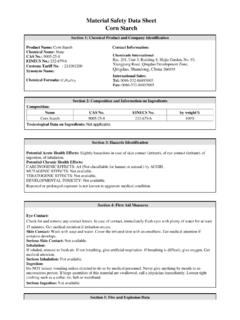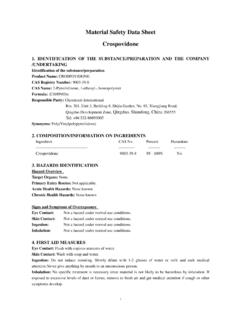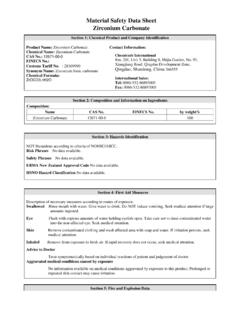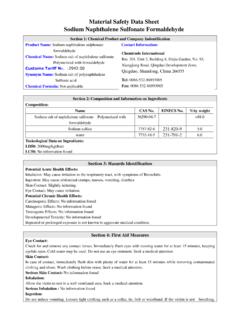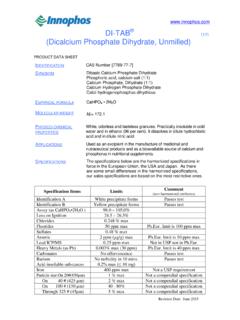Transcription of Material Safety Data Sheet Dicalcium Phosphate
1 Section 1: Chemical Product and Company Identification Product Name: Dicalcium Phosphate Anhydrous (Dihydrous) Contact Information: Chemical Name: CAS No.: 7757-93-9 EINECS No.: 231-826-1 Customs Tariff No.: 28352600 Synonym Name: ( Chemical Formula: CaHPO4 Section 2: Composition and Information on Ingredients Composition: Name CAS No. EINECS No. by weight% Dicalcium Phosphate 7757-93-9 231-826-1 100% Section 3: Hazards Identification EMERGENCY OVERVIEW: Physical Appearance and Odor: White powder solid, odorless. Warning Statements: Based on currently available data , this product does not meet the regulatory definition of a hazardous substance. However, good industrial hygiene practices should be used in handling it. POTENTIAL HEALTH EFFECTS: Acute Eye: May cause irritation.)
2 Acute Skin: Skin absorption not likely. May cause slight transient irritation, on prolonged contact. Acute Inhalation: Dusts may cause upper respiratory tract irritation. Acute Ingestion: This substance is commonly used as a component in food, vitamins and pharmaceutical tablets, and may be safely consumed in moderate amounts. Ingestion of large quantities may cause abdominal cramps, nausea, vomiting, diarrhea. Chronic Effects: This product does not contain any ingredient designated by IARC, NTP, ACGIH or OSHA as probable or suspected human carcinogens. Chemtrade International Rm. 201, Unit 3, Building 8, Shijia Garden, No. 93, Xiangjiang Road, Qingdao Development Zone, Qingdao, Shandong, China 266555 Tel & Fax: +86-532-86893005 Material Safety data Sheet Dicalcium Phosphate Section 5: Fire and Explosion data FIRE HAZARD data : Flash Point: Not Applicable Extinguishing Media: Not combustible.
3 Use extinguishing method suitable for surrounding fire. Special Fire Fighting Procedures: Firefighters should wear NIOSH/MSHA approved self-contained breathing apparatus and full protective clothing. Unusual Fire and Explosion Hazards: Not combustible. Hazardous Decomposition Materials (Under Fire Conditions): none known Section 6: Accidental Release Measures Evacuation Procedures and Safety : Wear appropriate protective gear for the situation. See Personal Protection information in Section 8. Containment of Spill: Follow procedure described below under Cleanup and Disposal of Spill. Cleanup and Disposal of Spill: Sweep or vacuum up and place in an appropriate closed container (see Section 7: Handling and Storage). Avoid creation of dusty conditions. Clean up residual Material by washing area with water and detergent.
4 DO NOT RETURN Material TO ITS ORIGINAL CONTAINER. Environmental and Regulatory Reporting: Section 7: Handling and Storage Minimum/Maximum Storage Temperatures: Not Available Handling: This is a food ingredient intended for human consumption. Keep containers closed when not being used. Storage: Store in closed containers. Store in an area that is cool, dry, sanitary, isolated from all toxic and harmful substances, This product is hygroscopic and tends to cake on storage. Section 8: Exposure Controls/Personal Protection Section 4: First Aid Measures FIRST AID MEASURES FOR ACCIDENTAL: Eye Exposure: Hold eyelids open and flush with a steady, gentle stream of water for at least 15 minutes. Seek medical attention if irritation develops or persists or if visual changes occur.
5 Skin Exposure: In case of contact, wash with plenty of soap and water. Seek medical attention if irritation developes or persists. Inhalation: If respiratory irritation or distress occurs remove victim to fresh air. Seek medical attention if respiratory irritation or distress continues. Ingestion: Do not induce vomiting unless instructed to do so by a physician. No harmful affects expected. If appreciable quantities are swallowed, call a physician or poison control center. Do not leave victim unattended. MEDICAL CONDITIONS POSSIBLY AGGRAVATED BY EXPOSURE: Inhalation of product may aggravate existing chronic respiratory problems such as asthma, emphysema or bronchitis. Skin contact may aggravate existing skin disease. NOTES TO PHYSICIAN: All treatments should be based on observed signs and symptoms of distress in the patient.
6 Consideration should be given to the possibility that overexposure to materials other than this product may have occurred. Treat symptomatically. No specific antidote available. Introductory Remarks: These recommendations provide general guidance for handling this product. Because specific work environments and Material handling practices vary, Safety procedures should be developed for each intended application. While developing safe handling procedures, do not overlook the need to clean equipment and piping systems for maintenance and repairs. Waste resulting from these procedures should be handled in accordance with Section 13: Disposal Considerations. Assistance with selection, use and maintenance of worker protection equipment is generally available from equipment manufacturers.
7 Exposure Guidelines: No exposure limits were found for this product or any of its ingredients. Engineering Controls: Where engineering controls are indicated by use conditions or a potential for excessive exposure exists, the following traditional exposure control techniques may be used to effectively minimize employee exposures: local exhaust ventilation at the point of generation. Respiratory Protection: When respirators are required, select NIOSH/MSHA approved equipment based on actual or potential airborne concentrations and in accordance with the appropriate regulatory standards and/or industrial recommendations. Eye/Face Protection: Eye and face protection requirements will vary dependent upon work environment conditions and Material handling practices. Appropriate ANSI Z87 approved equipment should be selected for the particular use intended for this Material .
8 It is generally regarded as good practice to wear a minimum of Safety glasses with side shields when working in industrial environments. Skin Protection: Skin contact should be minimized through use of gloves and suitable long-sleeved clothing ( , shirts and pants). Consideration must be given both to durability as well as permeation resistance. Work Practice Controls: Personal hygiene is an important work practice exposure control measure and the following general measures should be taken when working with or handling this Material : (1) Do not use, and/or consume foods, beverages, tobacco products, or cosmetics in areas where this Material is stored. (2) Wash hands and face carefully before eating, drinking, using tobacco, applying cosmetics, or using the toilet. (3) Wash exposed skin promptly to remove accidental splashes or contact with this Material .
9 Section 9: Physical and Chemical Properties Physical and Chemical properties here represent typical properties of this product. Contact the business area using the Product Information phone number in Section 1 for its exact specifications. Physical Appearance: White powder solid. Odor: Odorless. pH: Not Applicable Specific Gravity: Not Available Water Solubility: Slightly soluble wt/wt% at 100 C (212 F). Melting Point Range: Not Available Boiling Point Range: Not Available Vapor Pressure: Not Available Vapor Density: Not Available Molecular Weight: Section 10: Stability and Reactivity data Chemical Stability: This Material is stable under normal handling and storage conditions described in Section 7. Conditions To Be Avoided: dusting conditions extreme humidity Materials/Chemicals To Be Avoided: none known The Following Hazardous Decomposition Products Might Be Expected: Decomposition Type: thermal none known Hazardous Polymerization Will Not Occur.
10 Avoid The Following To Inhibit Hazardous Polymerization: not applicable Section 11: Toxicological Information Acute Eye Irritation: No test data found for product. Acute Skin Irritation: Toxicological Information and Interpretation: Skin - skin irritation, rabbit. Non-irritating. Acute Dermal Toxicity: No test data found for product. Acute Respiratory Irritation: No test data found for product. Acute Inhalation Toxicity: No test data found for product. Acute Oral Toxicity: Toxicological Information and Interpretation: LD50 - lethal dose 50% of test species, > 10000 mg/kg, rat. Chronic Toxicity: This product does not contain any substances that are considered by OSHA, NTP, IARC or ACGIH to be "probable" or "suspected" human carcinogens. Section 12: Ecological Information Ecotoxicological Information: No data found for product.
